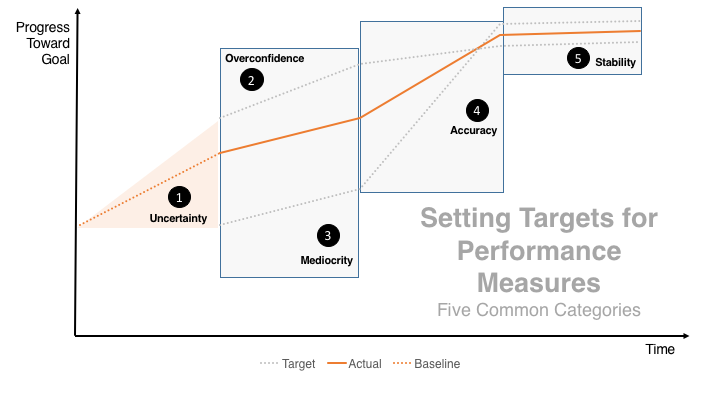Five Common Categories of Performance Targets
Setting strong targets can be both art and science; and governments should strive for as much science as possible. However, programs, departments, and organizations have varying levels of performance measurement and data science capacity. Therefore, GovEx developed this guide to give practical advice based on the five “common categories” of target setting in governments across the country.
All five target setting categories are illustrated in Figure 1. The graphic is intentionally conceptual, not based on real measures or targets, to make it more generalizable and applicable to a wider audience. The categories are often sequential but not mutually exclusive. One organization can have measures in multiple categories, or all the categories. They are simply commonly occurring, and therefore worth learning from.
What Should Governments Aim For? The ultimate goal is for governments to set accurate targets until they are sustainably reached. However, there is no wrong door to enter and no shame in any of these categories. Every government faces each category mentioned in this guide and must deal with uncertainty while sometimes reaching higher than their capacity. Every government has a few programs and measures that are "mediocre." This guide will provide quick do's and don'ts for every stage along the journey. In the end, the ideal state is continuous improvement, not perfection.
A quick summary of the five categories:
- Uncertainty: no baseline data exists to set appropriate targets without guessing
- Overconfidence: targets are unrealistic and unattainable based on baseline data
- Mediocrity: targets are far below proven capacity
- Accuracy: targets are carefully calculated to drive precise achievement
- Stability: performance has reached an acceptable level, time to maintain and shift focus
Figure 1

Goals vs. Targets
Many organizations have very precise definitions for the words goal and target. For example, a city may set a goal to end homelessness by 2018, and then set specific targets for each preceding year. Under this construct, the goal is the ultimate desired achievement, and the target is the path to get there. However, other organizations, including GovEx, use the words more interchangeably, because they are essentially the same thing: a specific quantity a program, department, or government is trying to achieve in the future. Because goals and targets have so much in common, GovEx has chosen to avoid making distinctions between them and encourages governments to use whichever terminology makes the most sense to its people and culture.
Goal statements
Goal statements are also commonly used in performance management, but are broader than goals and targets. Goal statements include qualitative as well as quantitative information, like “create a stronger and safer community for all residents by ending homelessness in 2018.” The goal/target in that statement is still zero homeless individuals by 2018, but language about stronger and safer communities has been added to provide context to the goal/target.